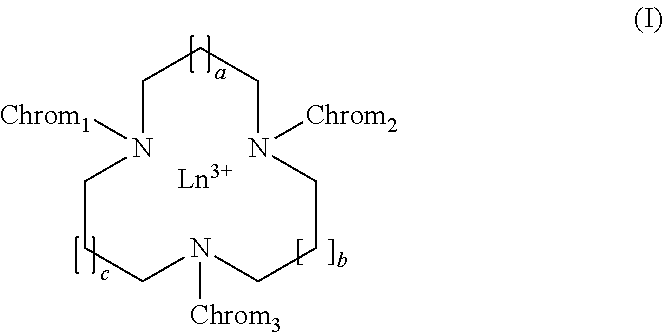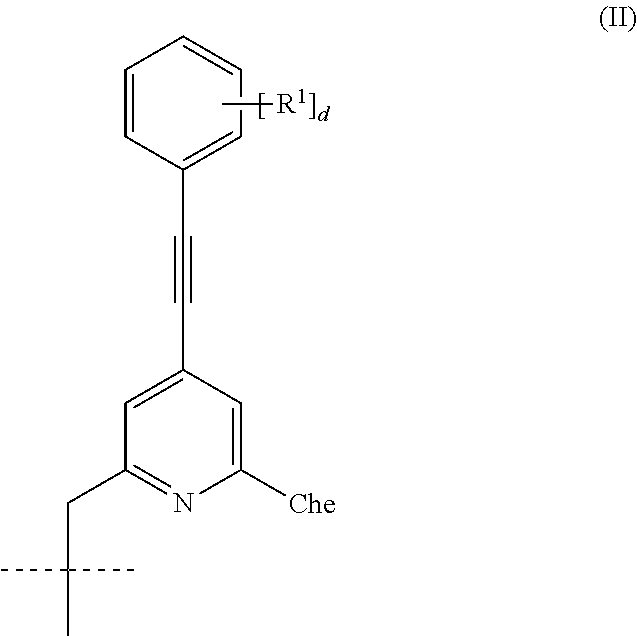Chromophoric structures for macrocyclic lanthanide chelates
a technology of macrocyclic lanthanide and chromophoric structure, which is applied in the field of azamacrocyclic lanthanide chelate design, can solve the problems of limited success in improving aqueous solubility by appending a peg group to the electron donor para-substitute, and achieves high solubility, reduces the volume of assay media, and advantages high aqueous solubility
- Summary
- Abstract
- Description
- Claims
- Application Information
AI Technical Summary
Benefits of technology
Problems solved by technology
Method used
Image
Examples
example 1
of Compound 3
[0091]A mixture of the compound 1 (0.34 g, 1.60 mmol; WO2011026790) and 2 (0.47 g, 2.15 mmol; Takalo, H., et al., Helv. Chim. Acta, 79(1996)789) in dry TEA (5 ml) and THF (10 ml) was de-aerated with argon. After addition of bis(triphenylphosphine)palladium(II) chloride (19 mg, 27 μmol) and Cul (10 mg, 53 μmol), the mixture was stirred for 24 hours at 55° C. After evaporation to dryness, the product (0.49 g, 94%) was purified by FC (silica gel, 10% EtOH / DCM / 1% TEA). 1H-NMR (CDCl3): 8.49; (1H, s), 8.08; (1H, s), 7.66; (2H, d, J=8.7 Hz), 7.60; (1 H, s,), 7.59; (2H, d, J=8.7 Hz), 4.85; (2H, s), 4.49; (2 H, q, J=7.1 Hz), 1.43; (3H, t, J=7.1 Hz). 13C-NMR (CDCl3): 164.55, 160.42, 155.24, 154.94, 154.64, 154.34, 147.42, 136.24, 133.10, 132.99, 125.58, 125.27, 120.30, 119.36, 118.94, 116.65, 114.35, 112.06, 94.24, 87.57, 64.30, 62.10, 14.18. MALDI TOF-MS mass: calculated (M+H+) 393.18; found 394.16
example 2
of Compound 4
[0092]A mixture of compound 3 (0.47 g, 1.20 mmol) and PBr3 (0.17 ml, 1.80 mmol) in dry CHCl3 (40 ml) was stirred for 18 h at +55° C., neutralized with 5% NaHCO3 solution (20 ml), the aqueous phase was extracted with CHCl3 (2×10 ml) and the combined organic phases were dried with Na2SO4. The product (0.43 g, 78%) was purified by FC (silica gel, 10% EtOH / DCM). 1H-NMR (CDCl3): 8.25; (1H, s), 8.01; (1H, d, J=1.1 Hz), 7.75; (1H, d, J=1.1 Hz); 7.68; (2H, d, J=8.7 Hz), 7.65; (2H, d, J=8.7 Hz); 4.62; (2H, s), 4.50; (2H, q, J=7.1 Hz), 1.45; (3H, t, J=7.1 Hz). 13C-NMR (CDCl3): 164.32, 157.68, 155.16, 154.85, 154.55, 154.25, 148.06, 136.21, 133.59, 133.06, 128.36, 126.09, 120.26, 119.32, 118.92, 116.62, 114.32, 112.03, 94.61, 86.29, 62.25, 32.62, 14.20. MALDI TOF-MS mass: calculated (M+H+) 455.02 and 457.02; found 455.78 and 457.73.
example 3
of Compound 6
[0093]A mixture of compound 4 (0.41 g, 0.90 mmol), 5 (0.14 g, 0.82 mmol), dry K2CO3 (0.23 g, 1.62 mmol) and dry MeCN (8 ml) was stirred for 24 h at RT. After filtration and washing the solid material with DCM, the filtrate was evaporated to dryness. The product (0.31 g, 53%) was purified by FC (silica gel, from 1% to 3% EtOH / DCM). 1H-NMR (D6-DMSO): 11.48; (1 H,s), 7.97; (1 H, s), 7.78-7.85; (3H, m), 7.66; (2H, d, J=8.3 Hz), 4.38; (2H, q, J=7.1 Hz); 3.80-3.85; (2H, m), 3.10-3.45; (8H, m), 2.65-2.75; (2H, m), 2.65-2.55; (2H, m), 1.43; (3H, s), 1.42; (3H, s), 1.40; (6H, s), 1.39 (6H, s), 1.34; (3 H, t, J=7.1 Hz). 13C-NMR (D6-DMSO): 164.09, 155.78, 154.96, 154.80, 154.70, 154.56, 154.37, 154.08, 147.22, 137.51, 132.74, 132. 54, 129.33, 127.03, 124.69, 120.85, 118.97, 116.69, 114.39, 112.62, 93.89, 86.35, 78.71, 61.44, 61.29, 51.42, 50.18, 49,69, 28.03, 14.02. Both spectra indicate the existence of rigid compound having different structural isomers. MALDI TOF-MS mass: calcul...
PUM
| Property | Measurement | Unit |
|---|---|---|
| wavelengths | aaaaa | aaaaa |
| temperature | aaaaa | aaaaa |
| temperature | aaaaa | aaaaa |
Abstract
Description
Claims
Application Information
 Login to View More
Login to View More - R&D
- Intellectual Property
- Life Sciences
- Materials
- Tech Scout
- Unparalleled Data Quality
- Higher Quality Content
- 60% Fewer Hallucinations
Browse by: Latest US Patents, China's latest patents, Technical Efficacy Thesaurus, Application Domain, Technology Topic, Popular Technical Reports.
© 2025 PatSnap. All rights reserved.Legal|Privacy policy|Modern Slavery Act Transparency Statement|Sitemap|About US| Contact US: help@patsnap.com



